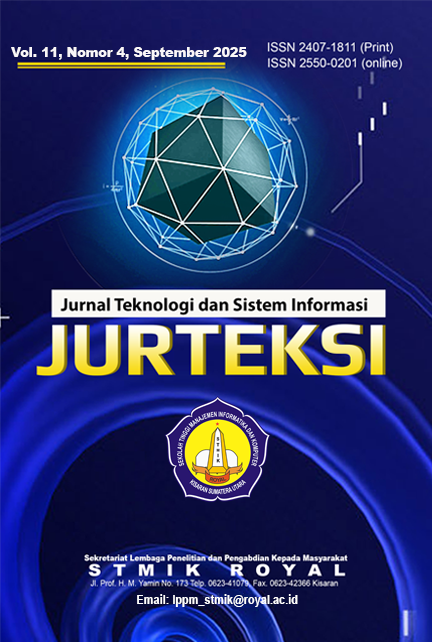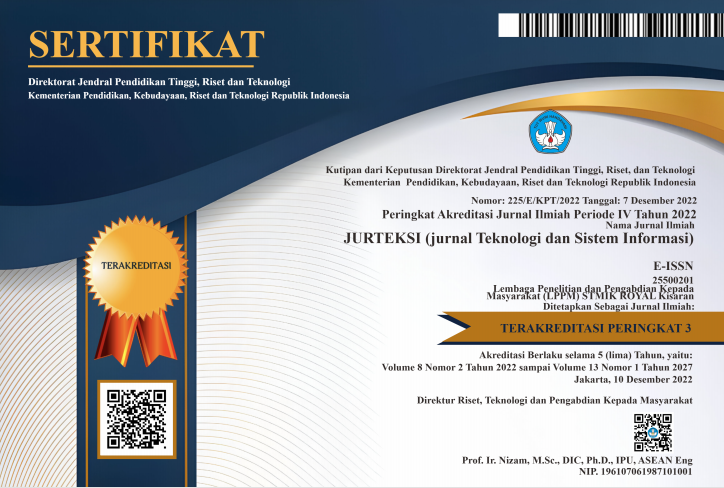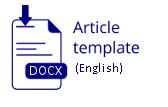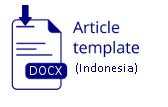CLOUD-DRIVEN OPTIMIZATION OF LECTURER PERFORMANCE DOCUMENT DIGITALIZATION USING AGILE UNIFIED PROCESS
Abstract
The development of digital technology encourages universities to improve effectiveness and efficiency in data management, particularly in recording and reporting faculty performance. Some lecturers still face difficulties in reporting their performance in the SISTER application due to challenges in locating documents scattered across various archives, which often leads to issues such as delays in reporting, low information accuracy, and lack of transparency of faculty performance documents for institutional needs. This study aims to optimize the digitalization of faculty performance documents based on cloud computing using the Agile Unified Process (AUP) approach, which is implemented in the development of a cloud-based system by utilizing Google Drive as the storage medium for digital faculty performance documents. The AUP methodology was chosen for its ability to combine flexible iterative and incremental principles, allowing the system to adapt quickly and continuously to user needs. Testing using Equivalence Partitioning, based on the functional and non-functional requirements of the system, has shown results in accordance with expectations.
References
[2] M. R. Suryawijaya and S. Prap-todiyono, “Pemanfaatan Komputasi Awan untuk Pengarsipan Digital di Indonesia,” J. Ilmu Komput. Dan Teknol., vol. 5, no. 3, pp. 1–7, Oct. 2024, doi: 10.35960/ikomti.v5i3.1479.
[3] Koneru Lakshmaiah Education Foundation, Vaddeswaram, India and V. P. B, “Assessment of Web-site Quality based on Appearance,” Int. J. Emerg. Trends Eng. Res., vol. 7, no. 10, pp. 360–375, Oct. 2019, doi: 10.30534/ijeter/2019/017102019.
[4] R. Irawan, “Pemodelan Sistem In-formasi Manajemen Surat Digital Terintegrasi Googgle Drive Menggunakan Unified Modeling Language Dengan Pendekatan Be-havioral Diagram,” vol. 22, no. 2.
[5] O. Al-Hujran, E. M. Al-Lozi, M. M. Al-Debei, and M. Maqableh, “Chal-lenges of Cloud Computing Adop-tion From the TOE Framework Per-spective:,” Int. J. E-Bus. Res., vol. 14, no. 3, pp. 77–94, July 2018, doi: 10.4018/IJEBR.2018070105.
[6] R. S. Ghumatkar and A. Date, “Software Development Life Cycle (SDLC),” Int. J. Res. Appl. Sci. Eng. Technol., vol. 11, no. 11, pp. 1162–1165, Nov. 2023, doi: 10.22214/ijraset.2023.56554.
[7] D. R. H. Pandjaitan and B. Hadian-to, “Website Quality, E-satisfaction, and E-loyalty of Users Based on The Virtual Distribution Channel,” J. Distrib. Sci., 2021.
[8] H. Gomaa, Software Modeling and Design: UML, Use Cases, Patterns, and Software Architectures. New York: Cambridge University Press, 2011.
[9] R. Irawan and R. Kaestria, “Pemod-elan Basis Data Dengan Pendekatan Model Data Berorientasi Objek Pa-da Native Apps Lokasi Tempat Iba-dah Di Kota Palangka Raya,” J. Sains Komput. Dan Teknol. Inf., vol. 2, no. 2, pp. 36–43, May 2020, doi: 10.33084/jsakti.v2i2.1479.
[10] R. S. Wazlawick, “Object-Oriented Analysis and Design for Infor-mation Systems: Modeling with UML, OCL, and IFML,” 2014. [Online]. Available: https://api.semanticscholar.org/CorpusID:61567274
[11] E. Abdelnabi, A. Maatuk, and T. Abdelaziz, An Algorithmic Ap-proach for Generating Behavioral UML Models Using Natural Lan-guage Processing. 2021, p. 6. doi: 10.1145/3492547.3492612.
[12] A. Javed, M. Shoaib, and A. Jaleel, “X-OODM: Explainable Object-Oriented Design Methodology,” IEEE Access, vol. 12, pp. 150807–150823, 2024, doi: 10.1109/ACCESS.2024.3477553.
[13] M. Al-Zewairi, M. Biltawi, and W. Etaiwi, “Agile Software Develop-ment Methodologies: Survey of Surveys,” J. Comput. Commun., vol. 05, pp. 74–97, Mar. 2017, doi: 10.4236/jcc.2017.55007.
[14] R. Irawan and S. Riyadi, “Analisis Dan Perancangan Sistem Informasi Laporan Kinerja Harian Dosen Dengan Pendekatan Object- Orient-ed Dan Agile Unified Process (AUP),” vol. 10, no. 2, 2023.
[15] S. W. Ambler, “The Agile Unified Process (AUP)”.
[16] O. Hazzan and Y. Dubinsky, Agile Software Engineering. in Under-graduate Topics in Computer Sci-ence. Springer London, 2009. [Online]. Available: https://books.google.co.id/books?id=kNFqQW3uZucC
[17] C. Edeki, “Agile Unified Process,” 2013. [Online]. Available: https://api.semanticscholar.org/CorpusID:62254179
[18] W. S. Usman, A. Mulyanto, A. A. Kadim, S. Suhada, and I. R. Padiku, “Implementasi framework Laravel dalam pengembangan website layanan administratif program studi,” vol. 6, no. 2.
[19] S. Aji, D. Pratmanto, A. Ardian-syah, and S. Saifudin, “Implemen-tasi Framework Laravel Dalam Perancangan Sistem Informasi De-sa,” Indones. J. Softw. Eng. IJSE, vol. 7, no. 2, pp. 237–246, Dec. 2021, doi: 10.31294/ijse.v7i2.12050.
[20] S. Ernawati and S. Rahayu, “Anali-sa Usability Pada Aplikasi Identitas Kependudukan Digital Menggunakan Metode Usability Testing,” BIOS J. Teknol. Inf. Dan Rekayasa Komput., vol. 5, no. 1, pp. 12–19, Nov. 2023, doi: 10.37148/bios.v5i1.87.
[21] A. Lupita Dyayu, B. Beny, and H. Yani, “Evaluasi Usability Aplikasi PeduliLindungi Menggunakan Metode Usability Testing dan Sys-tem Usability Scale (SUS),” J. Ma-naj. Teknol. Dan Sist. Inf. JMS, vol. 3, no. 1, pp. 395–404, Mar. 2023, doi: 10.33998/jms.2023.3.1.720.
[22] A. K. Darmawan, Moh. A. Hamzah, B. Bakir, M. Walid, A. Anwari, and I. Santosa, “Exploring Usability Dimension of Smart Regency Ser-vice with Indonesian Adaptation of The System Usability Scale (SUS) and User Experience Questionnaire (UEQ),” in 2021 International Con-ference on Computer Science, In-formation Technology, and Electri-cal Engineering (ICOMITEE), 2021, pp. 74–79. doi: 10.1109/ICOMITEE53461.2021.9650086.
[23] M. A. Ridwan and I. Nuryasin, “PENGUJIAN BLACK BOX PADA WEBSITE BJS PROPERTY MENGGUNKAN TEKNIK EQUIVALENCE PARTITIONING”.
[24] B. B. Sasongko, F. Malik, F. Ardi-ansyah, A. F. Rahmawati, F. D. Ad-hinata, and D. P. Rakhmadani, “Pengujian Blackbox Menggunakan Teknik Equivalence Partitions pada Aplikasi Petgram Mobile,” J. IC-TEE, vol. 2, no. 1, p. 10, Mar. 2021, doi: 10.33365/jictee.v2i1.1012.
[25] N. W. Rahadi and C. Vikasari, “Pengujian Software Aplikasi Perawatan Barang Milik Negara Menggunakan Metode Black Box Testing Equivalence Partitions,” In-fotekmesin, vol. 11, no. 1, pp. 57–61, Jan. 2020, doi: 10.35970/infotekmesin.v11i1.124.













